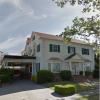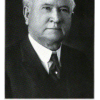PRESERVE THE PERLEY MANSION
BY HARRISON POWER
There are few buildings remaining in Modesto which hold the distinction of having been built prior to 1900, due to much of “Old Modesto” being torn down throughout mid-20th Century. Those sites that remain of that period are deserving of community appreciation and support as surviving vestiges of a bygine era in Modesto when expansive homes were commonplace in downtown – built by early Modesto settlers who contributed to the business and civic development of the city. As previously written about, one of these remaining Victorians is the now former Franklin and Downs Funeral Home located at 704 12th Street, originally built almost 130 years ago. To many in the area, the home has always been the longtime prominent funeral home; however, the house has connections to early Modesto community leaders who were committed to the betterment of the city and its inhabitants.
Completed by the end of 1895, the “palatial residence” was built for George Perley and his family. The Perley Mansion was a grand three-story home, designed in the East Lake style by Modesto architect Julian Mourot, who had also designed the old Tynan Hotel. The residence featured a rather distinct turret, ornate decorative trim details, and was fitted for gas plumbing and electricity. The mansion, adorned with French plate glass and stained-glass windows of all shapes and sizes, was considered “one of the handsomest residences in Modesto.”
George Perley moved to Modesto in the early 1870’s, and came to be regarded as a pioneer business and community leader. In 1879, he opened the City’s first abstracts and title office which supported a long career in real estate and development. In 1910, Perley was selected as one of 15 freeholders tasked with consideration of a new form of city government to better address the law-and-order needs of the growing town. This led to the drafting and adoption of the City Charter of 1910. Under the new Charter, Perley was elected to serve as one of Modesto’s first councilmen in 1911, and in that capacity held the position of commissioner of public works. He was a supporter of “progressive” civic reforms to improve and clean up the town, and even was the master of ceremonies for the christening celebration for the Modesto Arch in 1912. After committing half a century to the success of Modesto, George Perley passed away in 1923.
The home was sold to George Sovern and his business partner in 1921, who moved their mortuary business from 10th Street to the Perley Mansion. While the parlor was converted to better accommodate funeral services, much of the original 1895 mansion was kept intact under their ownership. George Sovern was also civic minded, and was elected in 1930 to serve as the County Coroner and Public Administrator, serving in those roles until his passing in 1938. The adjacent home, 1211 G Street, was the Sovern Residence. After 25 years in operation, Mrs. Dora Sovern sold the business and property to Lewis Franklin and Saxon Downs in 1946, after which time the home’s façade was remodeled into the Colonial Chapel as it is known today, by partially removing the rounded tower and enclosing the front porch areas. Franklin and Downs went on to do business in the same location for nearly 70 years.
While the exterior and layout of the home were changed over the years to better serve the needs of its three owners, the core of the home is still the original 1895 Perley Mansion with several existing features including stained glass windows, shingling, front porch pillars (enclosed within interior walls), and the curved staircase and banister. It continues to serve as a reminder of the earlier generations in Modesto that sought to contribute to the community and make it a better place to live. With no protections in place for the old stately icon of Downtown Modesto, long term plans for the property or chances for preservation become reliant on a prospective owner. Whatever the future may hold for the Perley Mansion, its loss would certainly be felt in the community as one of the surviving remnants of “Old Modesto.”
Photo Circa 1921 *Courtesy of the McHenry Museum












